General Contents
General: Why you should spend some time reading this if you have a chimney, fireplace, or woodburning stove.
History: Some of the pioneers in the field.
General Size Requirements: Chimney components and how they fit together. Inculdes a drawing on height requirements.
Safety and Convenience: Dumping ash, safely closing dampers etc.
Chimney Fires: Creosote buildup and finding the path between creosote and finding some efficiency.
Chimneys and Water Problems: Probably self explanatory.
Woodburning Stove Inserts: The most efficient and the most creosote.
Efficiency and Safety Enhancing Appliances: Heatilators to gas logs.
Just scroll down.
General: Why you should spend some time reading this if you have a chimney, fireplace, or woodburning stove.
History: Some of the pioneers in the field.
General Size Requirements: Chimney components and how they fit together. Inculdes a drawing on height requirements.
Safety and Convenience: Dumping ash, safely closing dampers etc.
Chimney Fires: Creosote buildup and finding the path between creosote and finding some efficiency.
Chimneys and Water Problems: Probably self explanatory.
Woodburning Stove Inserts: The most efficient and the most creosote.
Efficiency and Safety Enhancing Appliances: Heatilators to gas logs.
Just scroll down.
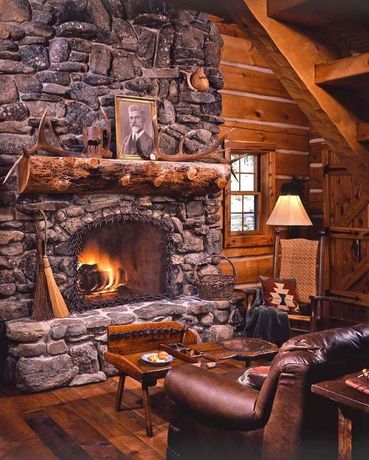 Stone chimney in the high rent district
Stone chimney in the high rent district General
This article is still a work in progress. I published in this stage because I'm sure there have already been chimney fires this year. This can help.
Nothing contained herein is meant to take the place of any code or regulation. Follow your code.
If you have questions, make a comment. Your comments and/or questions will help me make it better. We are using our chimneys already and the public as a whole is pretty ignorant about some of the hazards. I would like to change some of that.
Watch where the money goes. This part of the country spends on cooling much more than heating. The focus in the Houston area is unique to the south. In fact on a cold day a fireplace can cool your home down quite quickly. Our chimneys are built for the romantic roaring fire that consumes so much heated room air. It gives radiant heat to the living room but takes heated air for combustion from the whole home.
The first half of this will try to focus on why they are unique with minimal discussion of the dangers. The second half will focus on dangers of multiple types.
This article is still a work in progress. I published in this stage because I'm sure there have already been chimney fires this year. This can help.
Nothing contained herein is meant to take the place of any code or regulation. Follow your code.
If you have questions, make a comment. Your comments and/or questions will help me make it better. We are using our chimneys already and the public as a whole is pretty ignorant about some of the hazards. I would like to change some of that.
Watch where the money goes. This part of the country spends on cooling much more than heating. The focus in the Houston area is unique to the south. In fact on a cold day a fireplace can cool your home down quite quickly. Our chimneys are built for the romantic roaring fire that consumes so much heated room air. It gives radiant heat to the living room but takes heated air for combustion from the whole home.
The first half of this will try to focus on why they are unique with minimal discussion of the dangers. The second half will focus on dangers of multiple types.
 Google Image of Count Rumford
Google Image of Count Rumford History
It isn’t that the technology for getting the most heat out of wood doesn’t exist. Much of it has existed for centuries. I first learned about chimneys in 1984 at the Black Magic Chimney Sweep School in Stowe, Vermont.
I spent about 8 years sweeping and repairing chimneys; While working full time I was certified by the National Chimney Sweep Guild. That led me to a batch of home inspections per the VA and FHA.
Chimneys are a serious business in New England. The school taught us how to clean chimneys, how they were built, and something of minor and more serious repairs.
We learned about the pioneers in the technology of wood burning heat. One of them was Ben Franklin who specialized in stoves. Another was a man known as Count Rumford who also developed stoves. He is best known, however, for his theories on building fireplaces and chimneys that worked. That's about all the history I want to cover. You can get the rest of the theory here I would imagine.
http://en.wikipedia.org/wiki/Rumford_fireplace
Also the federal rules on fire prevention as applies to chimneys can be found by googling NFPA 211
When I returned to Houston I had to learn how they were built here. There are some differences and a synopsis of what I found follows.
It isn’t that the technology for getting the most heat out of wood doesn’t exist. Much of it has existed for centuries. I first learned about chimneys in 1984 at the Black Magic Chimney Sweep School in Stowe, Vermont.
I spent about 8 years sweeping and repairing chimneys; While working full time I was certified by the National Chimney Sweep Guild. That led me to a batch of home inspections per the VA and FHA.
Chimneys are a serious business in New England. The school taught us how to clean chimneys, how they were built, and something of minor and more serious repairs.
We learned about the pioneers in the technology of wood burning heat. One of them was Ben Franklin who specialized in stoves. Another was a man known as Count Rumford who also developed stoves. He is best known, however, for his theories on building fireplaces and chimneys that worked. That's about all the history I want to cover. You can get the rest of the theory here I would imagine.
http://en.wikipedia.org/wiki/Rumford_fireplace
Also the federal rules on fire prevention as applies to chimneys can be found by googling NFPA 211
When I returned to Houston I had to learn how they were built here. There are some differences and a synopsis of what I found follows.
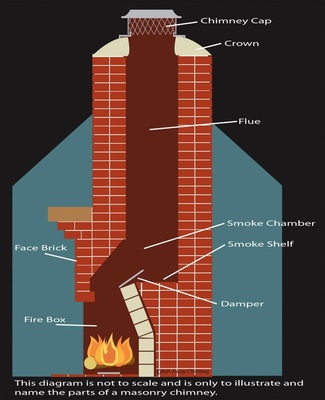 Google Image
Google Image General Size Requirements
The ratio of the height to the width of the inlet opening to the firebox should be between 2/3 and 3/4. In plain language it should look like a rectangle not a square.
Mostly they are built correctly here because otherwise they tend to smoke. A curved top like the first picture frequently smokes. The curve adds to the area of the opening and makes glass doors and other fixes more difficult.
If the chimney is a smoker there will be soot trails from the top of the opening, up the face brick, and staining the mantle.
The flue (tube running from smoke shelf to chimney cap) must have an area 10% as large as the firebox opening. A round flue swirls and can get away with being only 8.3% or 1/12 of the firebox opening. The idea is that less will not be large enough to take away the hot smoke that is produced. It is also a pretty good "sweet spot" because much larger makes a colder (expanded) smoke that forms a lot of creosote. That becomes important as we follow along.
If your builder knew this and the height requirements below you probably have a chimney that will work, albeit not terribly efficiently.
In the drawing above you can see the slit damper in place. Also the smoke shelf which curls smoke and sends it back up again. It has a sloping crown (masonry top) and a flue cap installed. That is important for critters and rain. The fire clay (a special mud) that holds the yellow bricks together is water soluble. The yellow (fire) bricks are not. You can tell if there is rain protection with little more than a glance at the fireplace back wall. There will be eroded clay holding the bricks.
The ratio of the height to the width of the inlet opening to the firebox should be between 2/3 and 3/4. In plain language it should look like a rectangle not a square.
Mostly they are built correctly here because otherwise they tend to smoke. A curved top like the first picture frequently smokes. The curve adds to the area of the opening and makes glass doors and other fixes more difficult.
If the chimney is a smoker there will be soot trails from the top of the opening, up the face brick, and staining the mantle.
The flue (tube running from smoke shelf to chimney cap) must have an area 10% as large as the firebox opening. A round flue swirls and can get away with being only 8.3% or 1/12 of the firebox opening. The idea is that less will not be large enough to take away the hot smoke that is produced. It is also a pretty good "sweet spot" because much larger makes a colder (expanded) smoke that forms a lot of creosote. That becomes important as we follow along.
If your builder knew this and the height requirements below you probably have a chimney that will work, albeit not terribly efficiently.
In the drawing above you can see the slit damper in place. Also the smoke shelf which curls smoke and sends it back up again. It has a sloping crown (masonry top) and a flue cap installed. That is important for critters and rain. The fire clay (a special mud) that holds the yellow bricks together is water soluble. The yellow (fire) bricks are not. You can tell if there is rain protection with little more than a glance at the fireplace back wall. There will be eroded clay holding the bricks.
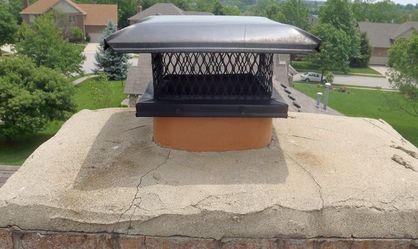 Google image
Google image This chimney has a masonry liner (terra cotta) although most codes would also approve metal. It appears to be a 1313 flue which is 11 by 11 inside diameter. That is an area 121 square inches. Therefore, it will support a firebox with a 1,210 square inch opening until the spark arrestor becomes clogged. A spark arrestor like this one can be restored by simply brushing. There is a lot more airflow in an upright arrestor like this. A spark arrestor that covers the top of the flue and is held down with rocks will clog very quickly. You will have smoke in the house.
If the flue is too small it will not allow the smoke to escape up the chimney. If it is too large the smoke will be allowed to expand and cool excessively. That makes creosote. It also means that the creosote will probably be glazed and expand terribly (like popcorn) in the event of a fire. We will address creosote and chimney fires downstream just a bit.
If the flue is too small it will not allow the smoke to escape up the chimney. If it is too large the smoke will be allowed to expand and cool excessively. That makes creosote. It also means that the creosote will probably be glazed and expand terribly (like popcorn) in the event of a fire. We will address creosote and chimney fires downstream just a bit.
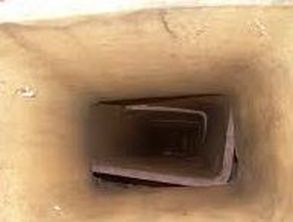 Google image Misaligned flue tiles. .
Google image Misaligned flue tiles. . You get a double whammy if the chimney is obstructed. The fire thinks the flue is undersized because of the obstruction and put smoke in the home. Once past the obstruction the smoke will think the flue is oversized. It will expand and cool. The exodus will become stagnant, and the smoke will create batches of creosote.
Of course in this case, that might be the least of your problems. This is unsafe to use, even for gas logs. These 2' terra cotta sections are misaligned and represent both restrictions and leaks. The chances of active fire outside the flue can hardly be fixed by any manner short of relining the chimney. That is hard and expensive.
Of course in this case, that might be the least of your problems. This is unsafe to use, even for gas logs. These 2' terra cotta sections are misaligned and represent both restrictions and leaks. The chances of active fire outside the flue can hardly be fixed by any manner short of relining the chimney. That is hard and expensive.
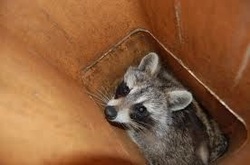 Google image
Google image Of course, sometimes the obstruction or restriction is mobile.
I have removed raccoons from chimneys by dangling a rope from the top and making a racket at the bottom of the chimney. That works unless there are young. Prevention is the key.
It is illegal (at least in my locale) to kill coons or birds nesting in a chimney. You wouldn't get me to do it anyway. Once the babies can fly or otherwise evacuate the area I was always happy to help. The flue cap pictured above is the key. Put it on before babies are born.
Youngsters cause a ruckus in most species. Coons, squirrels, and birds are no exception. You are almost certain to dislike the experience.
I have removed raccoons from chimneys by dangling a rope from the top and making a racket at the bottom of the chimney. That works unless there are young. Prevention is the key.
It is illegal (at least in my locale) to kill coons or birds nesting in a chimney. You wouldn't get me to do it anyway. Once the babies can fly or otherwise evacuate the area I was always happy to help. The flue cap pictured above is the key. Put it on before babies are born.
Youngsters cause a ruckus in most species. Coons, squirrels, and birds are no exception. You are almost certain to dislike the experience.
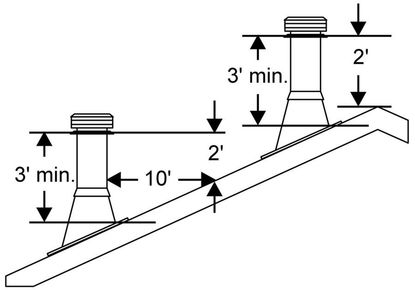 Google Image
Google Image There is a 10-2 rule for chimney height but even if you follow it you can have problems. It does not matter where the peak of the roof might be. It does matter that the chimney extend two feet above anything within ten feet.
I must stress that the chimney does not care if it is your roof - or your tree, The wind will rush down the roof line and the snout of your chimney should protrude above the wind. A tree that decides to grow downwind within a few feet of your chimney can cause a high pressure area that matters a lot. Luckily that is reduced when the leaves fall. Sometimes, in the south, they don't. A neighbor that builds an addition can also be problematic in a townhouse or condo. If you draw a circle around your chimney top with a 10' radius and your chimney is 2' higher than anything else - you are golden.
Different areas have different codes. If I recall correctly these are the same dimensions the Uniform Mechanical Code has for gas flue pipes.
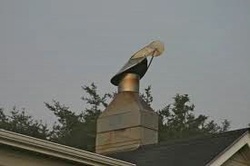 Google Image of conquistador cap
Google Image of conquistador cap Safety and Convenience
We have developed some pretty ingenious ways to fight smoking chimneys. If your builder has built to the correct height you should never need to fight the wind with a contraption like this. It is known as a conquistador cap and moves with the wind. I had one customer with a stubby chimney who had a motor mounted in the flue. It worked very poorly. Extending the chimney would have worked better but in the case I'm thinking of, 10' up would not have worked. Caveat emptor.
We have developed some pretty ingenious ways to fight smoking chimneys. If your builder has built to the correct height you should never need to fight the wind with a contraption like this. It is known as a conquistador cap and moves with the wind. I had one customer with a stubby chimney who had a motor mounted in the flue. It worked very poorly. Extending the chimney would have worked better but in the case I'm thinking of, 10' up would not have worked. Caveat emptor.
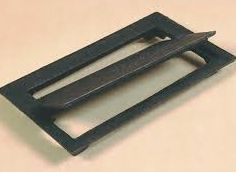 Google image of ash dump
Google image of ash dump This is an ash dump. If you have one of these in the floor of your fireplace you should use it. Ash tends to fly and modern air conditioners move it rapidly. Ask me how I know. A water spray bottle reduces the ash that flies around.
If there is a hole in the floor of your chimney that is about eight inches by four inches yours may have rusted away. If the chimney is in the center of your home it is unlikely (but not impossible) that you have one. That is because an ash dump is only half of a system. The other half is right below.
If there is a hole in the floor of your chimney that is about eight inches by four inches yours may have rusted away. If the chimney is in the center of your home it is unlikely (but not impossible) that you have one. That is because an ash dump is only half of a system. The other half is right below.
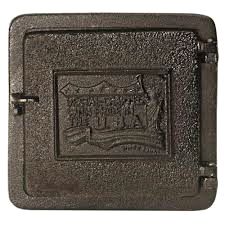 Google Image. Ash clean out door.
Google Image. Ash clean out door. This is a clean out door. This should be mortared in the back wall of your chimney . The idea is that ash can be safely dumped through the ash dump and allowed to sit till you are sure it is extinguished.
Then you go outside and shovel it into your metal bucket and go dump it where it won't burn down the neighborhood. I have seen these indoors but only infrequently.
Then you go outside and shovel it into your metal bucket and go dump it where it won't burn down the neighborhood. I have seen these indoors but only infrequently.
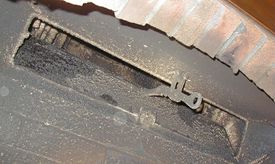 Google Image of slit (standard) damper and handle
Google Image of slit (standard) damper and handle This is the slit damper that is found in most masonry fireplaces. Should you have a chimney fire, this becomes the most important part of your fireplace. Note the hole in the end of the handle.
Now I don't know about you but I really do not want to stick my arm into a raging fire to pull (sometimes push) this handle. You should know where this is because it is important to know how to use it. If you are not using your fireplace (summer months) this is a big leak for conditioned air.
Now I don't know about you but I really do not want to stick my arm into a raging fire to pull (sometimes push) this handle. You should know where this is because it is important to know how to use it. If you are not using your fireplace (summer months) this is a big leak for conditioned air.
Find out if it pulls or pushes shut and make that the last time you get up close and personal unless it is warped.You might have to put insulation in the gap to avoid smells with a warped damper., otherwise, go out and buy this popular extension for your arm.
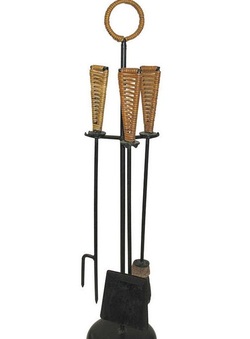 Google image fireplace tool set
Google image fireplace tool set This tool that you have called a poker all these years is the tool to open and close your standard damper. It bears some thought choosing which style will work best for you. A piece of rebar bent into an L with a duct tape handle would work quite well. Just stick whatever you choose into the hole in the handle and push or pull as appropriate.
This is better than the rebar because you won't have to face the ridicule over the duct tape. It also contains the shovel and the brush. Leaving an inch of ash on the floor of the fireplace is smart or so the story goes.
This is better than the rebar because you won't have to face the ridicule over the duct tape. It also contains the shovel and the brush. Leaving an inch of ash on the floor of the fireplace is smart or so the story goes.
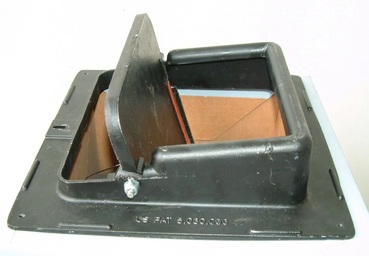 Google Image of a Lyemance Damper
Google Image of a Lyemance Damper If there is no flue cap you may wind up with the above damper rusting away. Should that happen this rig is the answer. It is operated via a chain at the firebox opening.
It is called a lyemance damper and you can buy them online. It sure beats rebuilding your chimney. You need to measure your flue opening before you order. it just glues to the top of the masonry flue tile.
It is called a lyemance damper and you can buy them online. It sure beats rebuilding your chimney. You need to measure your flue opening before you order. it just glues to the top of the masonry flue tile.
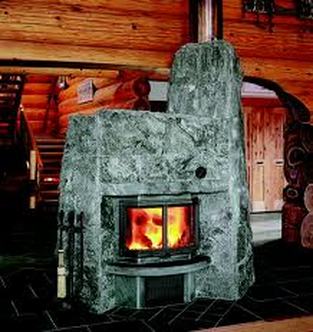 greenhomebuilding.com (russian stove)
greenhomebuilding.com (russian stove) Chimneys are not meant to warm your home with just radiant heat. That will only work for one room and it's not very efficient. The heat should indeed radiate but you are using conditioned air to make the fire. Lots of conditioned air. It cools your home.
The fire heats the bricks of the furnace and they are supposed to heat the home through a combination of radiation and air convection. Conduction plays it's part in heating all the bricks and the bricks are what heats the home more than the fire does directly.
Finnish or Russian stoves like this one have so much heat exchange built in that a short and fierce fire heats for several hours. This is google image credited to greenhomebuilding.com. It was labeled as a Finnish or Russian stove. The smoke travels through many passages before it leaves through the small pipe in the top. The brick gets hot and radiates heat without consuming air for hours after the fire is out. You will not have much creosote buildup because the fire is so fierce. A product from areas of the world that are further north.
The fire heats the bricks of the furnace and they are supposed to heat the home through a combination of radiation and air convection. Conduction plays it's part in heating all the bricks and the bricks are what heats the home more than the fire does directly.
Finnish or Russian stoves like this one have so much heat exchange built in that a short and fierce fire heats for several hours. This is google image credited to greenhomebuilding.com. It was labeled as a Finnish or Russian stove. The smoke travels through many passages before it leaves through the small pipe in the top. The brick gets hot and radiates heat without consuming air for hours after the fire is out. You will not have much creosote buildup because the fire is so fierce. A product from areas of the world that are further north.
Chimney fires, creosote buildup, and finding the path between creosote and some efficiency
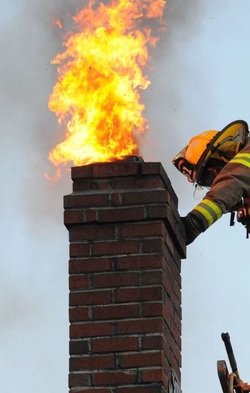 Google Image, chimney fire
Google Image, chimney fire Some wise guy said that a chimney fire is like a shipwreck at sea. It can ruin your whole day. This is what it can look like and it isn't the only way to ruin your home with a chimney. Just the most dramatic.
If you take a look at the slit damper four pictures up, the black wooly stuff on the damper is technically creosote. This is not the same stuff in which the old timers soaked fence posts and telephone poles. There was a creosoting place just north of Conroe and it was ugly but effective. They used totally different stuff.
Think about what happens when your hot breath hits the cold windows of your car first thing every morning. It fogs up doesn't it. Now imagine that your breath holds particulates. The hot breath of your fire does hold particulates and many of them are flammable. Your defroster heats the window and the fog disappears. The flue warms up and the fog disappears there also. Maybe. Because our southern chimneys are so inefficient the flues warm quickly and the creosote is easy to brush away. Again - maybe.
If you take a look at the slit damper four pictures up, the black wooly stuff on the damper is technically creosote. This is not the same stuff in which the old timers soaked fence posts and telephone poles. There was a creosoting place just north of Conroe and it was ugly but effective. They used totally different stuff.
Think about what happens when your hot breath hits the cold windows of your car first thing every morning. It fogs up doesn't it. Now imagine that your breath holds particulates. The hot breath of your fire does hold particulates and many of them are flammable. Your defroster heats the window and the fog disappears. The flue warms up and the fog disappears there also. Maybe. Because our southern chimneys are so inefficient the flues warm quickly and the creosote is easy to brush away. Again - maybe.
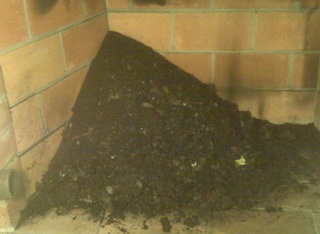 Google Image creosote pile in firebox
Google Image creosote pile in firebox This is the cause of the picture above. It is not ash. The ash was swept away before starting to sweep the chimney. This is black and probably glistens in places. If you don't think it's flammable look above again. Just ask any fireman what effect burning christmas wrapping paper might have. Most dangerous time of the year for chimney fires.
It is my understanding that these fires normally start with burning embers floating up and combusting the creosote in the smoke chamber. 360 plus days per year it will be burning wood embers. If there is a creosote buildup in the flue you develop a blast furnace.
The firebricks on the back wall in this picture do not appear to have seen enough fires to produce a lot of creosote. It may have had a woodburning stove properly inserted into the box. Who knows?
It is my understanding that these fires normally start with burning embers floating up and combusting the creosote in the smoke chamber. 360 plus days per year it will be burning wood embers. If there is a creosote buildup in the flue you develop a blast furnace.
The firebricks on the back wall in this picture do not appear to have seen enough fires to produce a lot of creosote. It may have had a woodburning stove properly inserted into the box. Who knows?
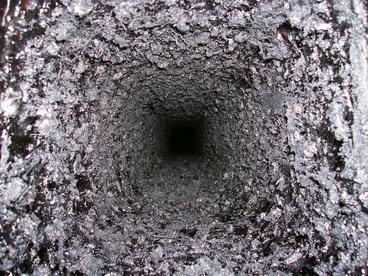 Google Image glazed (popcorn) creosote
Google Image glazed (popcorn) creosote Now this is what creosote looks like when something is efficient and built to keep heat in the home. That makes a colder smoke and a colder flue.
It also looks like this when there are restrictions in the flue somewhere. The same cold smoke results. This stuff can expand like popcorn in a chimney fire.
The smoke chamber above the damper is built so that creosote always develops. The smoke expands and builds there and then proceeds rapidly up the flue.
Creosote is bad in the smoke chamber and if you burn many fires you probably had a chimney fire there and didn't know it. They are tough to clean but if your chimney is built correctly they are safer than a flue fire. Look for creosote and clean your chimney if it's there.
I saw some little wire finger tools that were built to remove paint when used with a drill. I got some aircraft cable and drew what I wanted and a welder made a stripper for me. When used with a 3/8" drill, I could reach the bottom of the flue and cleaning the smoke chamber took possibly a minute. It really made the job easier and gave better results. It replaced the hardest and most poorly done part of the chimney sweep.
You may have seen the compounds that you throw on a fire to remove creosote. It doesn't. Creosote can be prevented and creosote can be swept. The compound can take credit for deterioration of anything metal like a damper. I also think it turns hard glazed creosote into something you can sweep more easily so it does have it's place.
I have swept chimneys with a hard glazed creosote and been unable to satisfy myself. I have told the customer to use this creosote remover for a few fires and let me return. Normally we saw much better results the second time. The old timers told me that rock salt does the same when thrown on the fire.
It also looks like this when there are restrictions in the flue somewhere. The same cold smoke results. This stuff can expand like popcorn in a chimney fire.
The smoke chamber above the damper is built so that creosote always develops. The smoke expands and builds there and then proceeds rapidly up the flue.
Creosote is bad in the smoke chamber and if you burn many fires you probably had a chimney fire there and didn't know it. They are tough to clean but if your chimney is built correctly they are safer than a flue fire. Look for creosote and clean your chimney if it's there.
I saw some little wire finger tools that were built to remove paint when used with a drill. I got some aircraft cable and drew what I wanted and a welder made a stripper for me. When used with a 3/8" drill, I could reach the bottom of the flue and cleaning the smoke chamber took possibly a minute. It really made the job easier and gave better results. It replaced the hardest and most poorly done part of the chimney sweep.
You may have seen the compounds that you throw on a fire to remove creosote. It doesn't. Creosote can be prevented and creosote can be swept. The compound can take credit for deterioration of anything metal like a damper. I also think it turns hard glazed creosote into something you can sweep more easily so it does have it's place.
I have swept chimneys with a hard glazed creosote and been unable to satisfy myself. I have told the customer to use this creosote remover for a few fires and let me return. Normally we saw much better results the second time. The old timers told me that rock salt does the same when thrown on the fire.
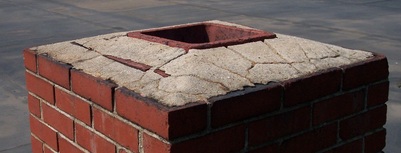 Google Image crown with cracks
Google Image crown with cracks Chimneys and Water
Another thing that can ruin your whole day is water in your home. Now I assume this chimney was built correctly. I assume the flue tiles are stacked straight with cemented joints. If all was done correctly the water will drain away and not damage the home.
In the fifth picture from the top you can have water leaks and smoke in the attic. I have seen both because of the way some southern chimneys are built. McMansions are probably the most likely to have problems. There is a real focus on appearance. Incidentally, the tile here should extend at least an inch further to allow for water splashing and to attach a flue cap.
This is also small enough that there may be masonry rubble between the flue and the chimney wall. That's a good thing. If the chimney were in the home instead of being stuck on an outside wall, that would be even more important. On the side of the home it still makes a difference but not for heating. Since heat goes to areas of less heat while seeking equilibrium the conducted heat will go to the great outdoors. This chimney will,however, be more solid than those just below. The rubble in the walls allow for conduction of heat to the external bricks. Lack of same means the flue contains all that heat with a low conductive pocket of air. Bad, bad news in a chimney fire. Shattered flue tiles.
Another thing that can ruin your whole day is water in your home. Now I assume this chimney was built correctly. I assume the flue tiles are stacked straight with cemented joints. If all was done correctly the water will drain away and not damage the home.
In the fifth picture from the top you can have water leaks and smoke in the attic. I have seen both because of the way some southern chimneys are built. McMansions are probably the most likely to have problems. There is a real focus on appearance. Incidentally, the tile here should extend at least an inch further to allow for water splashing and to attach a flue cap.
This is also small enough that there may be masonry rubble between the flue and the chimney wall. That's a good thing. If the chimney were in the home instead of being stuck on an outside wall, that would be even more important. On the side of the home it still makes a difference but not for heating. Since heat goes to areas of less heat while seeking equilibrium the conducted heat will go to the great outdoors. This chimney will,however, be more solid than those just below. The rubble in the walls allow for conduction of heat to the external bricks. Lack of same means the flue contains all that heat with a low conductive pocket of air. Bad, bad news in a chimney fire. Shattered flue tiles.
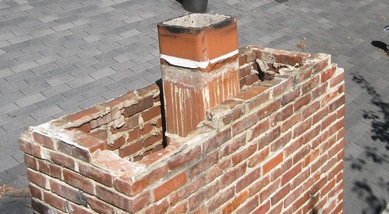 Google Image Cave in or middle of repair
Google Image Cave in or middle of repair I assume this caved in on it's own. I have found them like this all over Houston. They are built like the kids drink that is a box with a penetrating straw. Then plywood or some cheap alternative is placed as a bridge across the tops of the walls and a thin mortar laid on top. I have even seen shingles used to splash mortar on.
As you can imagine it doesn't take much of a weather event to make a crack in the mortar. After all, mortar is made for sticking bricks together,not for making a structure. Follow along with me then to the logical conclusion. Whatever that wood may be it gets wet and will rot. When it rots the logical conclusion is that it falls in. I wish I had a cell phone camera when I was doing sweeps. Homeowners frequently do not believe till they see.
As you can imagine it doesn't take much of a weather event to make a crack in the mortar. After all, mortar is made for sticking bricks together,not for making a structure. Follow along with me then to the logical conclusion. Whatever that wood may be it gets wet and will rot. When it rots the logical conclusion is that it falls in. I wish I had a cell phone camera when I was doing sweeps. Homeowners frequently do not believe till they see.
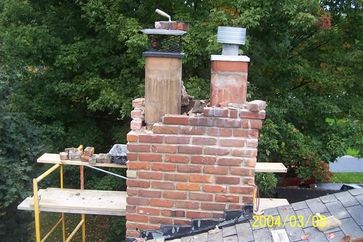 Google Image Double the fun
Google Image Double the fun I think this probably was removed for repair. The flue on the right looks newer to me and is likely to have more than one gas appliance. It could also be a wood burning stove. Who knows.
I can tell you one thing. It's not pretty when the rain fills a chimney.
I normally used wood to start a top. Metal flashing where it touched the flue. Then I used rebar and concrete. If you put up something with 2" or more concrete it's not going anywhere. Extend outwards just a bit and the bricks wouldn't be nearly so deteriorated.
Ok, lets tie this back into a chimney fire. If a flue is able to conduct heat away from itself there is a chance it will survive a chimney fire. If it has nothing but air to conduct the heat away it will shatter. That is why the chimney should be filled with masonry rubble. Terra Cotta is tough but not invincible.
If it is cracked but intact you might be able to line it with a metal flue. I have also done that with good results. The round flue can contain slightly less area and it might not be enough. If so, glass doors or a metal lip at the top of the firebox opening will drag the flue size/firebox opening into acceptable limits.
I can tell you one thing. It's not pretty when the rain fills a chimney.
I normally used wood to start a top. Metal flashing where it touched the flue. Then I used rebar and concrete. If you put up something with 2" or more concrete it's not going anywhere. Extend outwards just a bit and the bricks wouldn't be nearly so deteriorated.
Ok, lets tie this back into a chimney fire. If a flue is able to conduct heat away from itself there is a chance it will survive a chimney fire. If it has nothing but air to conduct the heat away it will shatter. That is why the chimney should be filled with masonry rubble. Terra Cotta is tough but not invincible.
If it is cracked but intact you might be able to line it with a metal flue. I have also done that with good results. The round flue can contain slightly less area and it might not be enough. If so, glass doors or a metal lip at the top of the firebox opening will drag the flue size/firebox opening into acceptable limits.
Woodburning Stove Inserts. Most efficient and most creosote
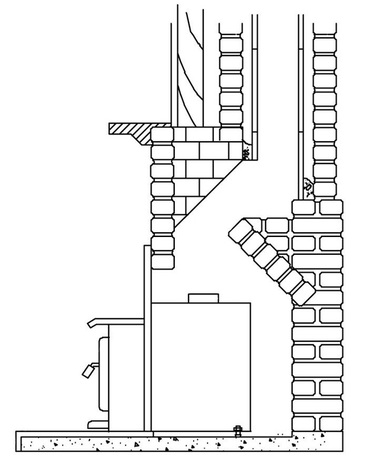 Google Imagewoodburning stove inserted into chimney
Google Imagewoodburning stove inserted into chimney There is a simple thing that cannot be overstated here. If the heat goes up the flue the creosote formation is lessoned. If it stays in the home the smoke is cooler and more creosote is formed. That is the simple way to understand whats happening.
How soon after a chimney sweep can you have a fire? Theoretically after one fire. Really, if that's the case why sweep a chimney.
Well would you rather have a little fire or a big fire. I would prefer the little one. This setup is guaranteed to have a big one if one starts. Why?
Well this is a stove stuck inside a masonry chimney. It's one of two types of appliances that is called an insert.
Of note, there is no stovepipe coming off the collar on the top of the stove. There is also no slit damper. A woodburning stove is very efficient so a lot more heat is left inside the home than with a fireplace. With no stove the fireplace sends that heat up the flue and not much creosote is created. With the stove, the smoke is cold from the start, expands tremendously, and makes creosote. Lots of it.
That is why most codes require a positive connection thru the damper and generally into the bottom of the flue. It takes two people to clean this setup. The stove must be removed and you then get behind it and remove gallons of creosote.It this should ignite it is Katie bar the door.
How soon after a chimney sweep can you have a fire? Theoretically after one fire. Really, if that's the case why sweep a chimney.
Well would you rather have a little fire or a big fire. I would prefer the little one. This setup is guaranteed to have a big one if one starts. Why?
Well this is a stove stuck inside a masonry chimney. It's one of two types of appliances that is called an insert.
Of note, there is no stovepipe coming off the collar on the top of the stove. There is also no slit damper. A woodburning stove is very efficient so a lot more heat is left inside the home than with a fireplace. With no stove the fireplace sends that heat up the flue and not much creosote is created. With the stove, the smoke is cold from the start, expands tremendously, and makes creosote. Lots of it.
That is why most codes require a positive connection thru the damper and generally into the bottom of the flue. It takes two people to clean this setup. The stove must be removed and you then get behind it and remove gallons of creosote.It this should ignite it is Katie bar the door.
Efficiency and safety enhancing appliances
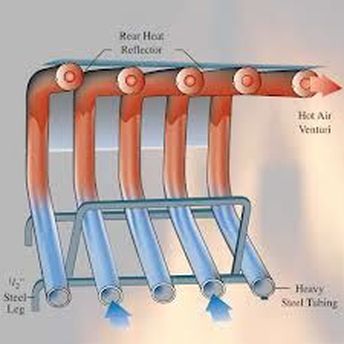 Google Image Heatilator fireplace grate
Google Image Heatilator fireplace grate This grate equals a great and inexpensive way to get some heat out of your fireplace without creating a batch of creosote. In the trade it is frequently called a heatilator.
Heatilator probably started as a brand name but now pretty much means anything that pulls in cold air and shoots heated air out. There is still plenty of heat going up the chimney so your fireplace does not abound with efficiency.
You won't make a batch of creosote either. It's a good middle ground. Thisi grate does it using no power at all. Simple knowledge that heat rises.
If it pleases you this can be purchased from dirt cheap to pretty expensive. It gets more expensive when it comes with inlet/outlets embedded into glass doors. You can pay even more by designing a system with a motor. I even saw one that had a motor, custom glass doors, and a thermostat for the blower motor. There was a pretty heavy amount of creosote in that chimney because of the efficiency. It was probably not much less efficient than a woodburning stove. I visited the house at least yearly and they depended on the fireplace to heat the house. They were not happy when I was no longer physically able to service them. Neither was I.
Heatilator probably started as a brand name but now pretty much means anything that pulls in cold air and shoots heated air out. There is still plenty of heat going up the chimney so your fireplace does not abound with efficiency.
You won't make a batch of creosote either. It's a good middle ground. Thisi grate does it using no power at all. Simple knowledge that heat rises.
If it pleases you this can be purchased from dirt cheap to pretty expensive. It gets more expensive when it comes with inlet/outlets embedded into glass doors. You can pay even more by designing a system with a motor. I even saw one that had a motor, custom glass doors, and a thermostat for the blower motor. There was a pretty heavy amount of creosote in that chimney because of the efficiency. It was probably not much less efficient than a woodburning stove. I visited the house at least yearly and they depended on the fireplace to heat the house. They were not happy when I was no longer physically able to service them. Neither was I.
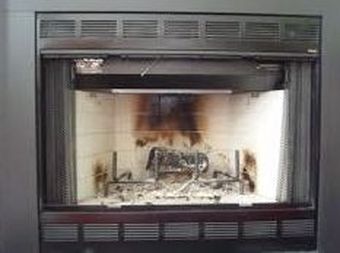 Google Image Heatalator fireplace with in/out louvers
Google Image Heatalator fireplace with in/out louvers This is sometimes called a heatilator fireplace. Air is pulled in the louvers at the bottom and shoots out the top. It cools the firebox and heats the room. Do not ever fit with glass doors that are not made exclusively for the chimney by the manufacturer. It depends on moving air for it's safety.
This chimney is also sometimes called an insert. I suppose the stove and this metal fireplace get that name because they are not built in place. It is just as much a fireplace as the big stone one at the top.
These tend to be less efficient than a masonry chimney for a couple reasons.
There are moving air pockets that cool a multi layered wall in most cases. That air frequently comes from the room you are heating.
It is also called a zero clearance fireplace because you can put your hand on the flue while it has a fire. Note the proximity of plywood in the picture below. This cool flue makes creosote. The metal lip coming down the top of the opening is probably a path for air for the firebox although this probably doesn't need it because of the heatilator effect described above..
This chimney is also sometimes called an insert. I suppose the stove and this metal fireplace get that name because they are not built in place. It is just as much a fireplace as the big stone one at the top.
These tend to be less efficient than a masonry chimney for a couple reasons.
There are moving air pockets that cool a multi layered wall in most cases. That air frequently comes from the room you are heating.
It is also called a zero clearance fireplace because you can put your hand on the flue while it has a fire. Note the proximity of plywood in the picture below. This cool flue makes creosote. The metal lip coming down the top of the opening is probably a path for air for the firebox although this probably doesn't need it because of the heatilator effect described above..
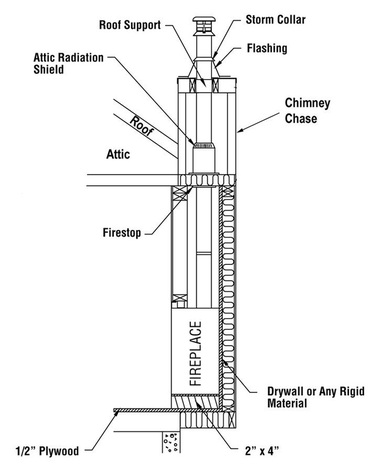 Google Image Zero clearance fireplace
Google Image Zero clearance fireplace There are aspects to this drawing that are new to me. This appears to be an insulated flue which means less creosote. The flue will warm up. You are more likely to find a double wall or triple wall flue.
The double wall flue is more efficient at cooling. A triple wall expects cold air to be falling down the outer chamber. That air is not really cold by the time it hits the bottom. Then the air is pulled into the middle chamber and starts getting hot while cooling the flue. It rises rapidly taking heat with it.
So where does the air to cool a double wall flue come from. Probably from your home. It can also come from the void inside the chase with an opening in your attic. The cleverest thing I saw had something like dryer vent covers on the outside of the chase. It could even have a cap that lets the cold air fall from under the flue cap down into the chase. It can come from anywhere you want but the firebox is probably cooled by room air.
The double wall flue is more efficient at cooling. A triple wall expects cold air to be falling down the outer chamber. That air is not really cold by the time it hits the bottom. Then the air is pulled into the middle chamber and starts getting hot while cooling the flue. It rises rapidly taking heat with it.
So where does the air to cool a double wall flue come from. Probably from your home. It can also come from the void inside the chase with an opening in your attic. The cleverest thing I saw had something like dryer vent covers on the outside of the chase. It could even have a cap that lets the cold air fall from under the flue cap down into the chase. It can come from anywhere you want but the firebox is probably cooled by room air.
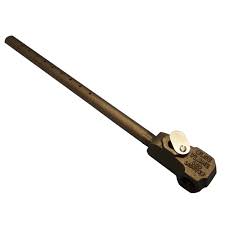 Google Image of gas log lighter
Google Image of gas log lighter If you have one of these in your fireplace you are ahead of the game. This is one of the blue flame log lighters that lets you adjust the flame by moving the little air inlet in the mixing bowl.
When you are starting your fire it will smoke because cold air is falling when you want warm air to go up. Start this first. The combustion is much more efficient and you can establish your draft. After 2-3 minutes of running this place your wood on the grate. You should be able to start the fire without smoke in the house. Oh yeah. Make sure your damper is open first. That has caused more problems than I care to think about.
This also means you have gas to your fireplace. Caution: You had better know whether it is natural gas or propane/butane because it makes a big difference.
When you are starting your fire it will smoke because cold air is falling when you want warm air to go up. Start this first. The combustion is much more efficient and you can establish your draft. After 2-3 minutes of running this place your wood on the grate. You should be able to start the fire without smoke in the house. Oh yeah. Make sure your damper is open first. That has caused more problems than I care to think about.
This also means you have gas to your fireplace. Caution: You had better know whether it is natural gas or propane/butane because it makes a big difference.
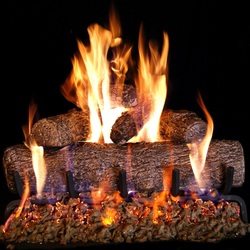 Google Image peterson gas logs.
Google Image peterson gas logs. This is a set of Peterson Real Fyre ceramic gas logs. The combustion is efficient. When I knew about such things I think that about 50% of the heat produced stayed in the room. Could be even better now.
You cannot tell someone that it will stop their draft problems to install gas logs. Experience tells me that it has in many cases. Especially those cases where the problem is a flue restriction or it is too small. The combustion is much more efficient and there is less smoke which should tell you something. The source of the radiant heat is the set of ceramic logs cleverly designed to have more surface area on the back side exposed to the flame. After fighting firewood for about ten years I installed a set in my fireplace. It heats the room and adds to the heat of the whole home. It starts that within five minutes. I recommend them and I think Peterson makes the Cadillac.
You cannot tell someone that it will stop their draft problems to install gas logs. Experience tells me that it has in many cases. Especially those cases where the problem is a flue restriction or it is too small. The combustion is much more efficient and there is less smoke which should tell you something. The source of the radiant heat is the set of ceramic logs cleverly designed to have more surface area on the back side exposed to the flame. After fighting firewood for about ten years I installed a set in my fireplace. It heats the room and adds to the heat of the whole home. It starts that within five minutes. I recommend them and I think Peterson makes the Cadillac.
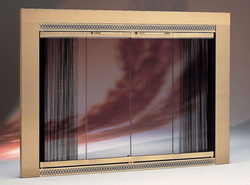 Google Image of fireplace glass doors
Google Image of fireplace glass doors Obviously this is a set of glass doors. They are pretty enough but there isn't anything special about them. There doesn't need to be. These are the answer if your firebox opening is too big (flue too small) or the fire is sucking heat out of the house.
It may help under conditions where the height is inadequate. When the wind would blow the smoke would head down the flue. It would gather behind these glass doors and then slowly go back up again.
You run your fire with them closed or mostly closed but the air inlet open. You will get heat radiated from the doors but not give up nearly so much air from the house. You can get them with a motorized heatalator grate and actually have some efficiency.
That's it for right now. If you have a question or a comment please leave a note. I will be adding when it occurs to me or when I insert the answer to a question.
It may help under conditions where the height is inadequate. When the wind would blow the smoke would head down the flue. It would gather behind these glass doors and then slowly go back up again.
You run your fire with them closed or mostly closed but the air inlet open. You will get heat radiated from the doors but not give up nearly so much air from the house. You can get them with a motorized heatalator grate and actually have some efficiency.
That's it for right now. If you have a question or a comment please leave a note. I will be adding when it occurs to me or when I insert the answer to a question.
 RSS Feed
RSS Feed